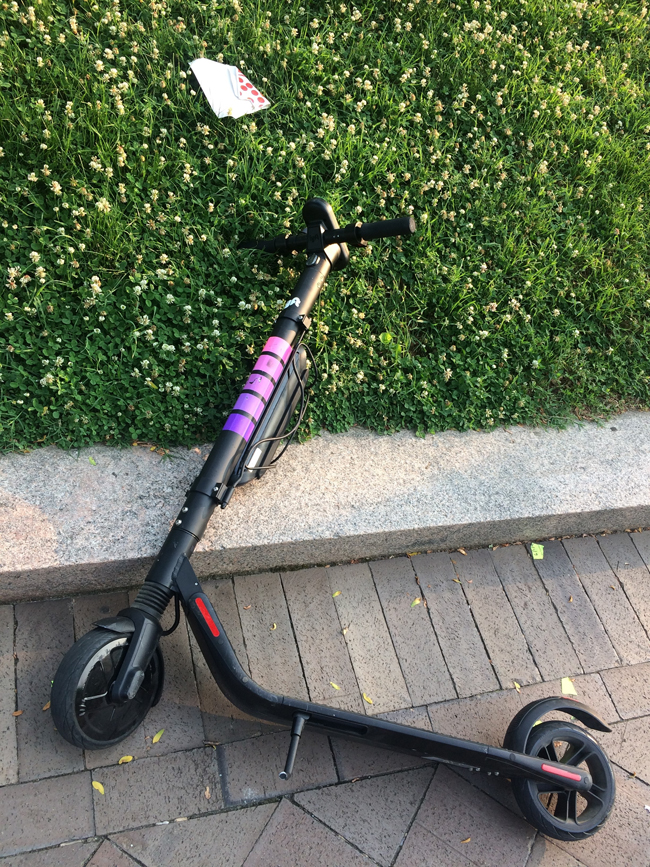
Electric scooters have been flooding into cities worldwide, but their improper use - and the related injuries - are causing some cities to take action. For instance, Paris mayor Anne Hidalgo is restricting the use of e-scooters on the streets of the French capital following a spate of injuries: problems are arising because riders have been spilling onto the City of Light’s narrow sidewalks and do not wear helmets.
Broken scooters are also being discarded on pavements, entrances to Metro stations or thrown over bridges into the River Seine. In short, it is “not far from anarchy”, Hidalgo suggested. Riders using pavements can be fined €135 while those blocking pedestrian access while parking face fines of €35. Operators are charged by the city for any broken scooters that need to be picked up by municipal workers.
Paris is not the only city battling against the influx of e-scooters in urban areas. In Georgia, US, the city of Alpharetta’s Grady Memorial hospital estimates that it receives 80 to 100 scooter-related injuries a month, according to a report by news outlet AJC. These include head injuries and broken limbs as e-scooters clutter pavements and disrupt traffic.
Elsewhere in Georgia, Athens-Clarke County has banned e-scooters for 12 months while the government develops new rules, and the city of Brookhaven only allows firms to operate 50 scooters each and regulates how they should be used and parked.
Lorry death
In the UK, the Metropolitan Police have caught nearly 100 people illegally riding e-scooters in London, reports The Daily Telegraph. Most of the riders received a warning but 10 people were fined and had their scooters seized due to speeding or ignoring red lights. The move follows the death of TV presenter and YouTube star Emily Hartridge, who was struck by a lorry while riding on an e-scooter in Battersea, south London.
Under UK law, e-scooters can be used on private property with the land owner’s permission - but it is illegal to ride them on the road, including those with cycle lanes or tracks or on the pavement.
The UK
In March, the UK government announced a review into transport, called Future of Mobility: Urban Strategy, which will explore regulations around new types of vehicles including e-scooters.
A DfT spokesperson told ITS International: “Safety is at the heart of our roads laws, and people who use e-scooters need to be aware it is currently illegal to ride them on the road and the pavement. The government is considering the use of e-scooters as part of its regulatory review. We are examining how they can be regulated for safe use on the road, while still encouraging innovative new forms of transport.”
Irresponsible use of e-scooters has also hit Denmark’s capital Copenhagen, where police arrested 28 people for riding under the influence of drugs and alcohol. Fines imposed on intoxicated riders of DAN2,000 krone (£235) do not appear to be enough to sway reckless behaviour, as locals are reportedly complaining about an increase in injuries.
The city emphasises that the alcohol blood limit for riding an e-scooter is 0.5 while driving under the influence is illegal. It also recommends that users always wear a helmet.
Extra steps
Companies have responded. In New Zealand, Lime has introduced an extra step for obtaining an e-scooter after 10pm in a bid to crack down on drunk riders. A report by Stuff says late-night users must confirm on the app that they can safely ride the e-scooter. If they type ‘Yes’, the e-scooter will unlock.
A police spokesperson confirmed that charges relating to drink-driving do not apply to e-scooters as they are not regarded as motor vehicles. However, riders exhibiting ‘poor behaviour’ on an e-scooter, including after drinking alcohol, could face a separate charge of careless use of a vehicle.

However, Jan Spence, the Christchurch City Mission’s alcohol and drug services manager, suggests that Lime could go further with these restrictions by implementing a time restriction on the scooters at night or by setting a speed limit to help reduce the risk.
Speaking to ITS International, a Lime spokesperson pointed out the company urges riders to wear helmets and requires them to watch “numerous safety tutorials” before unlocking their first scooter.
The company organises First Ride training sessions (First Ride Academy and Festival) in which riders learn how to ride responsibly and are encouraged to commit to safe-riding practices. “By signing the pledge, riders agree to ride responsibly at all times, abide by all traffic laws, ride only within designated areas such as streets and bike lanes, park properly out of the way of pedestrian walkways, service ramps, and metro stops, be aware of cars, pedestrians, and fellow riders,” Lime says.
Despite the risks that are being taken by riders, the company believes that scooters are among one of the safest transportation options.
“There is no specific risk linked directly to e-scooters - no more than a bike - and adopting responsible riding behaviours is key to improving safety and building a shared mobility community,” the spokesperson says.
Going forward, Lime adds that it is working with cities to “make roads safer for micromobility by building more protected bike lanes and infrastructure, such as special road signs for e-scooters, that can accommodate and protect these new transit options”.
E-scooters and the law
The
In a report called Safer Roads, Safer Cities: How To Improve Urban Road Safety in the EU, ETSC says regulations need to be defined on whether e-scooters compete for space on pavements, cycle paths or roads with motorised traffic.
The council insists that there is currently no reliable data in Europe on collisions involving e-scooters that resulted in road deaths or serious injuries. In addition, the police may not be called to a scene where a collision has taken place between an e-scooter that does not involve a motorised vehicle.
For the future, ETSC recommends member states legislate highway rules for e-scooters, add new field categories in police reports to distinguish collisions involving e-scooters and electrically-assisted bicycles and collect data on serious and fatal collisions involving an e-scooter.
It also suggests that European institutions conduct research on the road safety implications of e-scooters, including infrastructure needs, and consider developing guidance on managing safety aspects of personal e-transporters based on existing European best practice.

